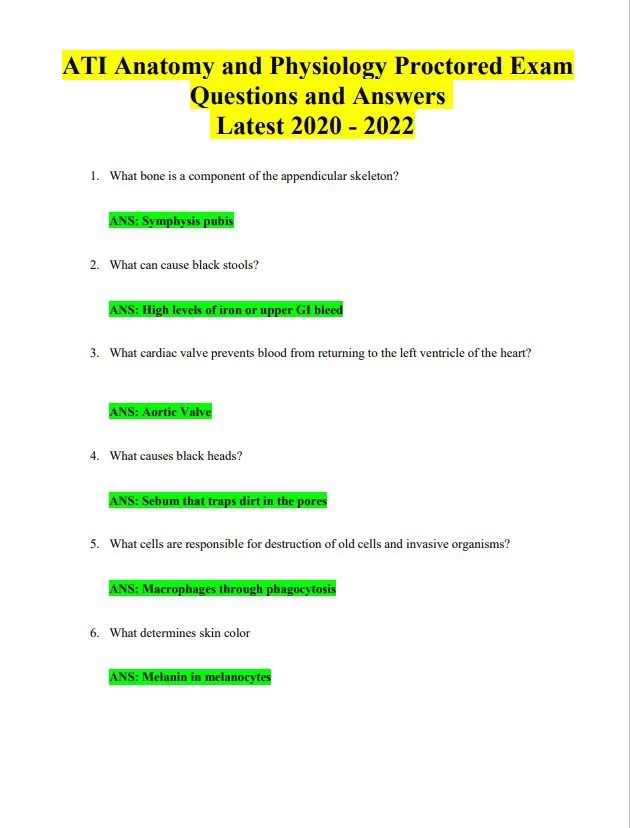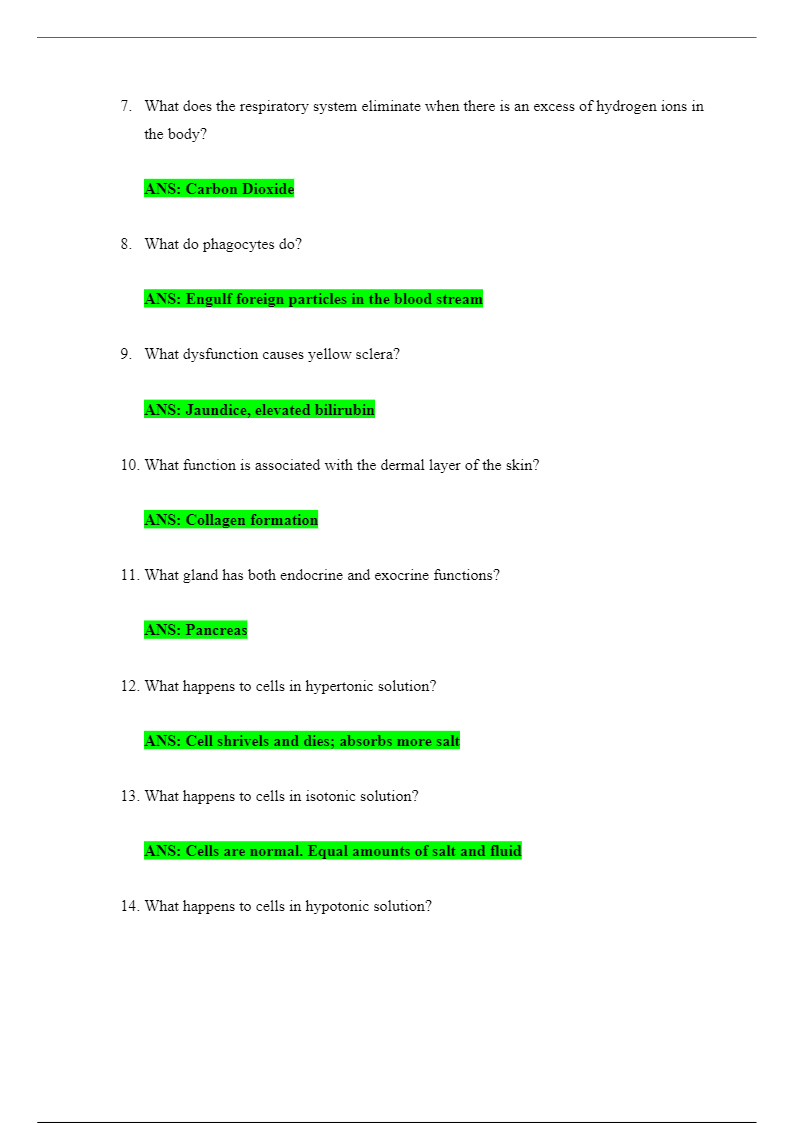ATI Anatomy and Physiology Proctored Exam. Questions and Answers. Latest 2020-2021
Instant DownloadYear: 2020-2021Pages:15
In Stock
Original price was: $150.00.$15.00Current price is: $15.00.
ATI Anatomy and Physiology Proctored Exam. Questions and Answers. Latest 2020-2021
- What bone is a component of the appendicular skeleton?ANS: Symphysis pubis
- What can cause black stools?ANS: High levels of iron or upper GI bleed
- What cardiac valve prevents blood from returning to the left ventricle of the heart?ANS: Aortic Valve
- What causes black heads?ANS: Sebum that traps dirt in the pores
- What cells are responsible for destruction of old cells and invasive organisms?ANS: Macrophages through phagocytosis
- What determines skin colorANS: Melanin in melanocytes
- What does the respiratory system eliminate when there is an excess of hydrogen ions in the body?ANS: Carbon Dioxide
- What do phagocytes do?ANS: Engulf foreign particles in the blood stream
- What dysfunction causes yellow sclera?ANS: Jaundice, elevated bilirubin
10. What function is associated with the dermal layer of the skin?ANS: Collagen formation11. What gland has both endocrine and exocrine functions?ANS: Pancreas12. What happens to cells in hypertonic solution?ANS: Cell shrivels and dies; absorbs more salt13. What happens to cells in isotonic solution?ANS: Cells are normal. Equal amounts of salt and fluid14. What happens to cells in hypotonic solution?
ATI Anatomy and Physiology Proctored Exam: Questions and Answers (Latest 2020-2021)
The ATI Anatomy and Physiology Proctored Exam is a comprehensive assessment designed to evaluate nursing students’ understanding of key concepts in anatomy and physiology. This exam is a crucial part of the ATI (Assessment Technologies Institute) testing series and is often used to assess students’ readiness for nursing practice. The questions and answers provided in this guide are based on the latest 2020-2021 exam format and content, ensuring that students are well-prepared for their assessments.
Overview
Exam Content
- Anatomy and Physiology Basics: Covers fundamental concepts related to the structure and function of the human body.
- System-Specific Knowledge: Includes detailed questions on various body systems, such as the cardiovascular, respiratory, digestive, musculoskeletal, and nervous systems.
- Integration of Knowledge: Assesses the ability to apply anatomical and physiological concepts to clinical scenarios.
Question Types
- Multiple-Choice Questions: The majority of questions are multiple-choice, requiring students to select the best answer from a list of options.
- Select All That Apply (SATA): Some questions may require selecting all correct answers from a list.
- Scenario-Based Questions: Includes case studies and clinical scenarios to test application of knowledge.
Answer Rationales
- Detailed Explanations: Provides comprehensive explanations for both correct and incorrect answers.
- Conceptual Understanding: Helps students understand the reasoning behind each answer, reinforcing learning.
Key Features
Comprehensive Coverage
- In-Depth Review: Thorough review of all major topics in anatomy and physiology as relevant to the ATI exam.
- Current Information: Reflects the latest exam content and format from 2020-2021.
Clear and Concise Format
- User-Friendly: Information is organized in an easy-to-follow format, with clear headings and subheadings.
- Visual Aids: Includes diagrams, charts, and tables to enhance understanding of complex concepts.
Interactive and Engaging
- Active Learning: Practice questions and rationales encourage active recall and application of knowledge.
- Study Tools: Flashcards, quizzes, and mnemonics included to reinforce key concepts.
Key Topics Covered
Cell Biology and Tissue Types
- Cell Structure and Function: Understanding the components of cells and their roles.
- Tissue Types: Differentiation between epithelial, connective, muscle, and nervous tissues.
Integumentary System
- Skin Structure: Layers of the skin and their functions.
- Accessory Structures: Hair, nails, and glands and their roles in the body.
Skeletal System
- Bone Structure: Types of bones, bone cells, and bone remodeling.
- Joint Types: Different types of joints and their movements.
Muscular System
- Muscle Anatomy: Types of muscle tissue (skeletal, cardiac, smooth) and muscle structure.
- Muscle Function: Mechanisms of muscle contraction and movement.
Cardiovascular System
- Heart Anatomy: Structure of the heart, including chambers, valves, and major vessels.
- Circulatory Pathways: Understanding systemic and pulmonary circulation.
Respiratory System
- Respiratory Anatomy: Structures involved in breathing, including the lungs and respiratory passages.
- Gas Exchange: Mechanisms of oxygen and carbon dioxide exchange.
Digestive System
- Digestive Anatomy: Organs involved in digestion and their functions.
- Digestive Processes: Mechanisms of digestion, absorption, and metabolism.
Nervous System
- Neuroanatomy: Structure and function of the central and peripheral nervous systems.
- Neurophysiology: Mechanisms of nerve impulse transmission and reflexes.
Endocrine System
- Hormone Production: Major endocrine glands and their hormones.
- Hormonal Regulation: Mechanisms of hormone action and regulation.
Reproductive System
- Male and Female Anatomy: Structures and functions of reproductive organs.
- Reproductive Processes: Understanding the menstrual cycle, pregnancy, and childbirth.
Urinary System
- Kidney Function: Structure and function of the kidneys and the process of urine formation.
- Fluid and Electrolyte Balance: Mechanisms of maintaining homeostasis.
Benefits of the Guide
For Students
Focused Learning
- High-yield content ensures students focus on the most critical concepts for the ATI Anatomy and Physiology Proctored Exam.
- Simplified explanations and visual aids enhance comprehension and retention.
Efficiency and Convenience
- Organized format allows for efficient study sessions, making the most of available time.
- Portable notes and guides can be used for study sessions anywhere and anytime.
Confidence Building
- Practice questions and detailed rationales help build confidence and reduce exam anxiety.
- Comprehensive preparation ensures students are well-prepared for all aspects of the exam.
For Educators
Supplemental Teaching Tools
- Guides and notes complement lectures and course materials.
- Practice questions can be integrated into classroom activities and assessments.
Assessment and Feedback
- Practice questions help assess students’ understanding and progress.
- Detailed rationales provide constructive feedback for improvement.
Practical Applications
Self-study and Review
- Use the guide for detailed self-study sessions to build a strong foundation in anatomy and physiology.
- Quick review with concise notes to reinforce key concepts before exams.
Group Study Sessions
- Collaborate with peers using flashcards, practice questions, and rationales for interactive learning.
- Use guides and notes as a reference during group discussions and study sessions.
Exam Preparation
- Thorough preparation with comprehensive guides and detailed explanations.
- Practice with realistic ATI exam questions to ensure readiness for the proctored exam.
Conclusion
The “ATI Anatomy and Physiology Proctored Exam: Questions and Answers (Latest 2020-2021)” guide is a valuable resource for nursing students preparing for their anatomy and physiology assessments. With its comprehensive content review, realistic practice questions, and effective study strategies, this guide provides a thorough and well-rounded approach to mastering anatomy and physiology concepts. Whether used for self-study, group activities, or exam preparation, these resources are designed to help students succeed in their nursing education and future careers.



Reviews
There are no reviews yet.